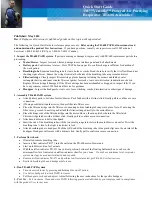
95
Insulation
Due to our policy of continuous product innovation, some specifications may change without notification.
©LG Electronics U.S.A., Inc., Englewood Cliffs, NJ. All rights reserved. “LG” is a registered trademark of LG Corp.
INSULATION
Y-branch Insulation.
Insulator
(included with kit)
Liquid and vapor
pipe joints
Insulator for
field piping
Tape
(field supplied)
Insulate the header using
the insulation attached to
the branch pipe kit as shown.
Insulator
Field pipe
insulator
Tape
Header Insulation.
Joints between branch and pipe should be sealed
with tape included in each kit.
Capped pipes should be insulated using the cap included in each kit, and then taped as shown.
Tape
Cap pipe
Pipe Insulator Cap
(included with Header Kit)
Additional Insulation for Y-Branches and Headers May be Required in Humid Environments.
If the system has been operating for a long time in a high humidity environment (dew point temperature: more than 73°F), condensate is likely to
form. If this happens, install 3/8 inch thick ethylene propylene diene methylene (EPDM) insulation that is plenum-rated with a heat-resistance factor
of more than 248°F.
Applying Insulation to Y-Branch and Header Fittings
LG Y-branches and Headers should be insulated with the clam-shell insulation jacket that is provided with each component. Check the fit of
the insulation jacket after all pipes are brazed to fittings. Mark all pipes at the point where the insulation jacket ends. Remove the insulation
jacket. Install field-supplied insulation on the pipe segments first, and then install the LG provided insulation plugs on the ends of all unused
Header ports. Apply the clam-shell insulation on jackets to Y-branch and Header fittings last. Peel the adhesive glue protector slip from the
insulation jacket and install the insulation jacket over the fitting.
















































